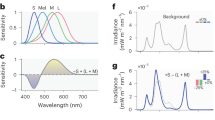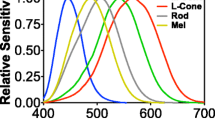Abstract
Melatonin (C13H16N2O2) has a wide range of functions in the body. When is inappropriately exposed to light at night, human circadian rhythm will be interfered and then melatonin secretion will become abnormal. For nearly three decades great progresses have been achieved in analytic action spectra and melatonin suppression by various light conditions. However, so far few articles focused on the quantitative calculation of melatonin suppression induced by light. In this article, an algorithm is established, in which all the contributions of rods, cones, and intrinsically photosensitive retinal ganglion cells are considered. Calculation results accords with the experimental data in references very well, which indicate the validity of this algorithm. This algorithm can also interpret the rule of melatonin suppression varying with light correlated color temperature very well.




Similar content being viewed by others
References
Armstrong SM, Redman JR (1991) Melatonin: a chronobiotic with anti-aging properties? Med Hypotheses 34(4):300–309
Beaudot WHA (1996) Adaptive spatiotemporal filtering by a neuromorphic model of the vertebrate retina. In: IEEE international conference on image processing, pp 427–430
Belenky MA, Smeraski CA, Provencio I, Sollars PJ, Pickard GE (2003) Melanopsin retinal ganglion cells receive bipolar and amacrine cell synapses. J Comp Neurol 460(3):380–393
Berson DM (2007) Phototransduction in ganglion-cell photoreceptors. Pflugers Arch 454(5):849–855
Cajochen C, Munch M, Kobialka S, Krauchi K, Steiner R, Oelhafen P (2005) High sensitivity of human melatonin, alertness, thermoregulation, and heart rate to short wavelength light. J Clin Endocrinol Metab 90(3):1311–1316
Dacey DM (2000) Parallel pathways for spectral coding in primate retina. Annu Rev Neurosci 23:743–775
Dacey DM, Liao HW, Peterson BB, Robinson FR, Smith VC, Pokorny J, Yau KW, Gamlin PD (2005) Melanopsin-expressing ganglion cells in primate retina signal colour and irradiance and project to the LGN. Nature 433(7027):749–754
Dawson D, Armstrong SM (1996) Chronobiotics—drugs that shift rhythms. Pharmacol Ther 69(1):15–36
Dowling JE (1987) The retina: an approachable part of the brain. The Belknap Press of Harvard University Press, Cambridge, pp 42–80
Doyle SE, Castrucci AM, McCall M, Provencio I, Menaker M (2006) Nonvisual light responses in the Rpe65 knockout mouse: rod loss restores sensitivity to the melanopsin system. Proc Natl Acad Sci USA 103(27):10432–10437
Dumitrescu ON, Pucci FG, Wong KY, Berson DM (2009) Ectopic retinal ON bipolar cell synapses in the OFF inner plexiform layer: contacts with dopaminergic amacrine cells and melanopsin ganglion cells. J Comp Neurol 517(2):226–244
Famiglietti EV, Kolb H (1975) A bistratified amacrine cell and synaptic circuitry in the inner plexiform layer of the retina. Brain Res 84(2):293–300
Figueiro MG, Rea MS, Bullough JD (2006) Circadian effectiveness of two polychromatic lights in suppressing human nocturnal melatonin. Neurosci Lett 406(3):293–297
Güler AD, Altimus CM, Ecker JL, Hattar S (2007) Multiple photoreceptors contribute to nonimage-forming visual functions predominantly through melanopsin-containing retinal ganglion cells. Cold Spring Harb Symp Quant Biol 72:509–515
Hampson EC, Vaney DI, Weiler R (1992) Dopaminergic modulation of gap junction permeability between amacrine cells in mammalian retina. J Neurosci 12(12):4911–4922
Hardeland R, Reiter RJ, Poeggeler B, Tan DX (1993) The significance of the metabolism of the neurohormone melatonin: antioxidative protection and formation of bioactive substances. Neurosci Biobehav Rev 17(3):347–357
Hokoc JN, Mariani AP (1987) Tyrosine hydroxylase immunoreactivity in the rhesus monkey retina reveals synapses from bipolar cells to dopaminergic amacrine cells. J Neurosci 7(9):2785–2793
Jusuf PR, Lee SC, Hannibal J, Grünert U (2007) Characterization and synaptic connectivity of melanopsin-containing ganglion cells in the primate retina. Eur J Neurosci 26(10):2906–2921
Kawasaki A, Kardon RH (2007) Intrinsically photosensitive retinal ganglion cells. J Neuroophthalmol 27(3):195–204
Kolb H (1970) Organization of the outer plexiform layer of the primate retina: electron microscopy of golgi-impregnated cells. Phil Trans R Soc B 258(823):261–283
Kouyama N, Marshak DW (1992) Bipolar cells specific for blue cones in the macaque retina. J Neurosci 12(4):1233–1252
Kozaki T, Koga S, Toda N (2008) Effects of short wavelength control in polychromatic light sources on nocturnal melatonin secretion. Neurosci Lett 439(3):256–259
Lewy AJ, Wehr TA, Goodwin FA, Newsome DA, Markey SP (1980) Light suppresses melatonin secretion in humans. Science 210(4475):1267–1269
Lockley SW, Brainard GC, Czeisler CA (2003) High sensitivity of the human circadian melatonin rhythm to resetting by short wavelength light. J Clin Endocrinol Metab 88(9):4502–4505
Lockley SW, Evans EE, Scheer FA, Brainard GC, Czeisler CA, Aeschbach D (2006) Short-wavelength sensitivity for the direct effects of light on alertness, vigilance, and the waking electroencephalogram in humans. Sleep 29(2):161–168
Maestroni GJ (2001) The immunotherapeutic potential of melatonin. Expert Opin Investig Drugs 10(3):467–476
Mariani AP (1984) Bipolar cells in monkey retina selective for cones likely to be blue-sensitive. Nature 30(5955):184–186
Miller SC, Pandi-Perumal SR, Esquifino AI, Cardinali DP, Maestroni GJM (2006) The role of melatonin in immunoenhancement: potential application in cancer. Int J Exp Pathol 87(2):81–87
Morita T, Tokura H (1996) Effects of lights of different color temperature on the nocturnal changes in core temperature and melatonin in humans. Appl Hum Sci 15(5):243–246
Nayak SK, Jegla T, Panda S (2007) Role of a novel photopigment, melanopsin, in behavioral adaptation to light. Cell Mol Life Sci 64(2):144–154
Nelson R (1982) AII amacrine cells quicken the time course of rod signals in the cat retina. J Neurophysiol 47(5):928–947
Østergaard J, Hannibal J, Fahrenkrug J (2007) Synaptic contact between melanopsin-containing retinal ganglion cells and rod bipolar cells. Invest Ophthalmol Vis Sci 48(8):3812–3820
Perez-Leon JA, Warren EJ, Allen CN, Robinson DW, Lane Brown R (2006) Synaptic inputs to retinal ganglion cells that set the circadian clock. Eur J Neurosci 24(4):1117–1123
Poeggeler B, Saarela S, Reiter RJ et al (1994) Melatonin a highly potent endogenous radical scavenger and electron donor: new aspects of the oxidation chemistry of this indole accessed in vitro. Ann N Y Acad Sci 738:419–420
Rea MS, Bullough JD, Figueiro MG (2001) Human melatonin suppression by light: a case for scotopic efficiency. Neurosci Lett 299(1–2):45–48
Rea MS, Figueiro MG, Bullough JD, Bierman A (2005) A model of phototransduction by the human circadian system. Brain Res Rev 50(2):213–228
Revell VL, Skene DJ (2007) Light-induced melatonin suppression in humans with polychromatic and monochromatic light. Chronobiol Int 24(6):1125–1137
Revell VL, Arendt J, Terman M, Skene DJ (2006) Short-wavelength sensitivity of the human circadian system to phase-advancing light. J Biol Rhythms 20(3):270–272
Roorda A, Williams DR (1997) The arrangement of the three cone classes in the living human eye. Nature 397(6719):520–522
Sato M, Sakaguchi T, Morita T (2005) The effects of exposure in the morning to light of different color temperatures on the behavior of core temperature and melatonin secretion in humans. Biol Rhythm Res 36(4):287–292
Srinivasan V, Spence DW, Pandi-Perumal SR, Trakht I, Esquifino AI, Cardinali DP, Maestroni GJ (2008) Melatonin, environmental light, and breast cancer. Breast Cancer Res Treat 108(3):339–350
Stevens RG, Blask DE, Brainard GC (2007) Meeting report: the role of environmental lighting and circadian disruption in cancer and other diseases. Environ Health Perspect 115(9):1357–1362
Strettoi E, Raviola E, Dacheux RF (1992) Synaptic connections of the narrow-field, bistratified rod amacrine cell (AII) in the rabbit retina. J Comp Neurol 325(2):152–168
Vaney DI (1994) Patterns of neuronal coupling in the retina. Prog Ret Eye Res 13:301–355
Wong KY, Dunn FA, Graham DM, Berson DM (2007) Synaptic influences on rat ganglion-cell photoreceptors. J Physiol 582(Pt 1):279–296
Acknowledgments
We are grateful for the technical assistance from Associate Prof. X.X. Xu, the Key Laboratory of Weak Light Nonlinear Photonics, Ministry of Education, China; logistical and editorial assistance from Prof. C.P. Zhang and Vice President Prof. C.Y. Li, School of Physics, Nankai University, China.
Author information
Authors and Affiliations
Corresponding author
Rights and permissions
About this article
Cite this article
Meng, Y., He, Z., Yin, J. et al. Quantitative calculation of human melatonin suppression induced by inappropriate light at night. Med Biol Eng Comput 49, 1083–1088 (2011). https://doi.org/10.1007/s11517-011-0788-1
Received:
Accepted:
Published:
Issue Date:
DOI: https://doi.org/10.1007/s11517-011-0788-1




